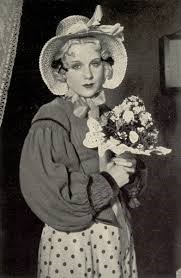Article in Progress: “Then, I go among the Germans”: Klein Dorrit (1934)
This post has been contributed by Andrea Schmidt, who is currently a Visiting Instructor of German at Willamette University. She has research interests in nineteenth century British/German literatures and contemporary film.

Film Star Anny Ondra in an image from the German film magazine Film-kurier
In an era of rising nationalism, a Czech born director brought an adaptation of a nineteenth-century British novel to German screens. This research examines the production and reception of a Czech-German adaptation of Charles Dickens’s Little Dorrit, titled Klein Dorrit (1934). The source text has been largely ignored in the focus on the adaptations of some of Dickens’s more popular novels, such as Bleak House or Great Expectations. (The significantly smaller number of Little Dorrit adaptions certainly also contributes to the lack of scholarship.) Aside from brief encyclopedic entries, little extensive writing on this film exists in either English or German. Directed by Carel Lamac (of Czech nationality, but working in the German language) and starring Czech/German film actor Anny Ondra, Klein Dorrit certainly differs in content and tone from Dickens’s original novel: The diminutive Amy Dorrit of Dickens’s tome turns into a feisty heroine working to improve not only the social conditions of her family but England as a whole; the tension between England and the Continent remains largely non-existent; religious Puritanism and its spectres disappear from the narrative; the prisons featured within the film resemble more of a convivial festival atmosphere. It would be easy to label Klein Dorrit a crowd-pleasing romp of what many view as one of Dickens’s minor novels. The film in many ways replicates the triteness of what many nineteenth-century German critics saw as a representative characteristic of Dickens’s works. The differences, however, rather than detracting from the original itself, open a number of avenues of inquiry that highlight changing technologies and historical tensions of the respective time periods of the texts (Victorian England versus pre- World War II Germany).
This research then investigates intermedial and intertextual references present throughout Lamac’s adaptation, and their own interrogation of the socio-historical climate in Germany in that time period. Though Klein Dorrit focuses, in essence, on a Victorian text, how does it reflect the transition from the Weimar Republic to the beginnings of Nazi Germany? The film lies at the historical juncture of the end of the Weimar Expressionist movement and rise of the UFA productions: How did Ondra’s portrayal of Little Dorrit reconcile the “new sexuality” of the Weimar women with the retroactive Nazi feminine ideals? How did the film’s portrayal of poverty, working-class conditions and an often cruel/decadent upper-class critique the rise of fascism? Third, how did the film use oft-criticized elements of the costume literary adaptation (the excessive devotion to costume and mise-en-scène) to subvert what some consider a genre devoted to a conservative representation of the past? Fourth, to what extent does the film also fall complicit with a promotion of a nostalgic vision of the past in another country? The overall framework of the project examines to what extent these adaptations “transmute” the rise of populism and fascism in pre- World War II Europe into settings of the eighteenth/nineteenth century. I would suggest that this text functions as a transnational heritage film, a work that includes the appropriation of one nation’s history or culture by another.
